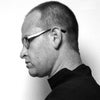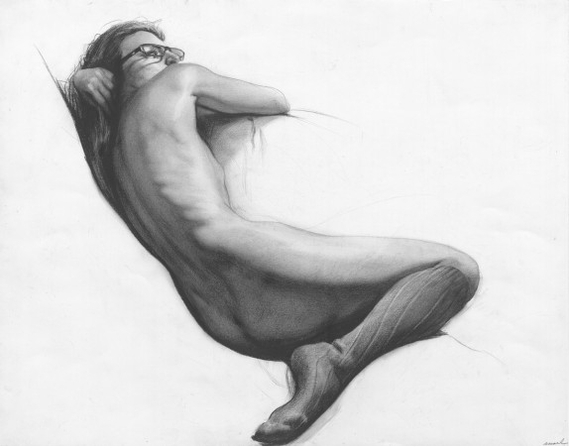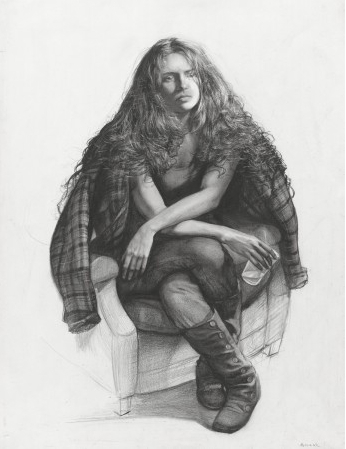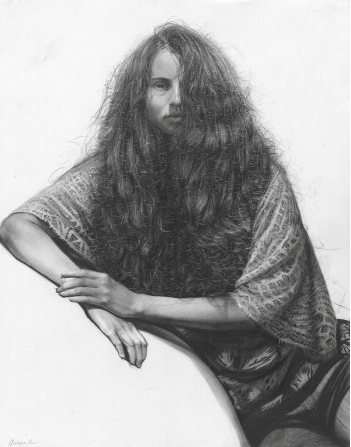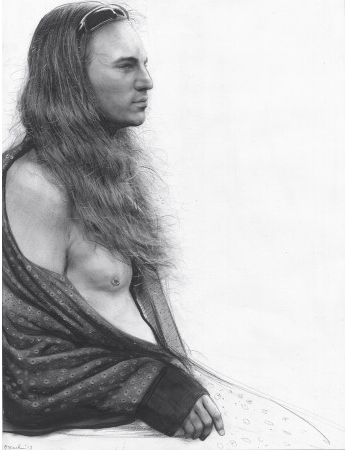A collection of drawings by Steven Assael is on display right now at Forum Gallery in Manhattan. Assael is universally known by high-technique figurative painters working in the United States today, among whom his skills are legendary.
Suyeon Lee 2013, graphite and crayon on paper, 14" x 10.75"
Consider three types of people who might wander into this show. First you have people completely ignorant of the topics of contention in contemporary art. This audience will unselfconsciously enjoy the work, because it consists of very beautiful drawings of people, and such viewers have not been instructed that beautiful drawings of people are now claimed to be wanted.
A second type of person comes to this show. This person, like me, is aware of the topography of contemporary art and has chosen to cast their lot, for better or worse, with the figurative artists. We will very likely cast a critical eye on the show, because our very hands know the innards of Assael's technique. But on the whole, we will tend to enjoy his show, because he is spectacularly good at what he does. And whatever else we get from work, we get a lot from talent married to skill.
A third type of person comes to this show. This person is a partisan of the trends in art after 1970 or so. They have doctrinal issues with talent, skill, and highly rendered figurative work. To them, all of this work looks obsolete and "photographic." It is not bad -- well, it is bad -- but mainly, it is irrelevant.
Figure Reclining with Glasses
2013, graphite and crayon on paper, 14" x 18"
Let me talk to all three of these types of person as they may have come upon this article, but chiefly to the third. My goal in reading art criticism is sometimes to understand more deeply the things I already like, but often it is to expand the range of things I can see -- that I can really see. I frequently read writers in the third category. I want them to speak to me, and I want to speak to them.
A thing I have noticed about people in the third category is that they are often very astute about subtle distinctions and developments in representational art from the dawn of time to 1945. But a blindness afflicts them in applying the same set of aesthetic considerations to work that is new. The obsolete/photographic filter kicks in, and the gaze turns away.
Let's say you are one of these people, and that you mirror me -- like me, you want to be able to see more. Let's say that the intellectual development of art precludes your resuscitation of any of the old questions to which an artist like Assael may dedicate himself. What does he have to say to you? How can you even begin to approach him?
I turn to my own experience as an artist, which is not a question of history or philosophy, but of my individual life, improvised now. Knowing what I know about how I have made my work, I recognize what Assael is up to. I believe there is a door for you here. Consider part of a monologue that Andrey Tarkovsky gives his main character, Alexander, in his final film, The Sacrifice (1986):
Once, you know, a very long time ago, an elder in a monastery... stuck a dry tree into a mountain. He commanded his novice -- Ioann Kolov -- it was a Russian orthodox monastery -- to water this tree every day until it came to life.And each day, over the course of many years, Ioann filled his bucket each morning with water and set off on his way. It took him all day, from sunrise to sunset, to carry one bucketful into the hills. Each morning Ioann would set off uphill with his bucket of water; he watered this stem, and each evening, when it was already dark, he would return to his monastery. So it went for three whole years. And then, one fine day, he ascended the mountain and saw: the tree was completely covered -- every inch -- with flowers!
What do we learn from this? Alexander, a materialist by inclination, draws one moral:
Say what you like, method and system are things of key importance! You know, sometimes I think that if I perform exactly the same action, every day, at exactly the same time -- as though a ritual -- systematically and without deviation, each day, and invariably at the very same time, the world will change! Something will change!
Alexander concludes that the purpose of this repetition is its ability to change the world. He is not incorrect, but I think his perspective is very partial. The procedure he is reasoning about, even though he does not clearly grasp it, is prayer. I use prayer here very broadly; I am not only talking about church prayer and synagogue prayer, but about walking your dog, or going to yoga, or practicing meditation, or throwing twenty fruits and vegetables in your juicer in the morning. These all answer to a crucial human need: to anchor time, and in the anchoring, to break free of the petty chaos of total selfhood, reaching toward some ideal greater than the self. Many ideals will do: god, family, health, serenity, empathy.
This is what Assael is doing. He draws all the time. He is working toward two ideals: excellence and insight. The first ideal -- excellence -- is defined with regard to material technique. This is the ideal of talent married to skill. How does one draw a muscle, or a certain tautness or slackness of skin? How does one foreshorten a bone, or depict each kind of cloth in its turn? How does one portray where the reflection of light is most intense, and where the shadows settle deepest? How does one distribute white, grey, and black over a flat surface, so that they interface with grace, and invite the eye to look?
Julie Holding Glass 2011, graphite and crayon on paper, 18" x 14"
The second ideal -- insight -- has to do with his relation to the people he draws. In his mute way, he treasures them. A lot of life drawing aspires to the extraordinarily difficult level of drawing bodies as objects. Assael aspires to the more difficult goal of drawing bodies as people. His work deviates radically from what he sees, groping along the contours of the personhood before him, and rendering that personhood as a physical phenomenon -- a seen thing. But what he depicts is not the form of the flesh, it only correlates with it. As is the case with many artists who follow this path, he has found a counterpart who resonates particularly with the texture of his insight. His model Julie sits for him again and again, and endlessly fascinates him. In her, he is able most clearly to see the entire humanity for which he thirsts.
Julie Facing 2013, graphite and crayon on paper, 14" x 11"
But these are his ideals, not his daily experience. What is his daily experience?
Consider again Ioann Kolov, the monk with the bucket of water. Can you imagine he was so saintly that he didn't have a purpose in mind with all that watering? Of course he did; the flowers, when they came, were no surprise. He had pictured them every day, he yearned for the flowers. But the importance of his act was in the faith, in walking over parched land to a dead tree every day for years, with no evidence coming of the reward, which retreated like a mirage. He kept walking, until the walking was its own reward, until he made himself over as the saint who was not in it for the flowers. And then, on the day that he finally no longer walked to get flowers, on that day the flowers came.
This is what Assael does. Like Ioann Kolov, he spends all day walking up and down the mountain. His tree has long since grown its flowers, but he continues; anyone carrying out a process of such sustained intensity does it in large part for how it transforms not the world, but himself. Assael draws as a form of spiritual purification. It gives his life order and meaning. He renews his faith through his drawing, and cleanses himself of his fears and his sins. The goal of his drawing is scarcely the drawing. The drawing is the substrate of the bonds between Assael and himself, and his people, and his world, and his god.
Alex with Patterned Shirt 2013, graphite and crayon on paper, 14" x 10.75"
Well, why should we bother to look at that? Because that is all art has ever been. Real art is the byproduct of a conscious process that transcends it, but which is encoded in it, and accessible to the viewer who makes the pilgrimage to it. That is its mighty power. Art is not color, shape, line, and value. Art is not an idea. Just as flesh and time are the garments of the soul, formal elements and ideas are the garments of art. Art is not meant to be looked at, but through. Once you open its door, you will find in art a thing made of the same transcendental medium as yourself. This is as true of the monastic discipline of a Steven Assael as it is of the rigorous formalism of a Donald Judd. If you can see this blinding revelation in the Judd, you have everything you need to see it in the Assael. And if you do not see it in the Judd, you are not getting enough out of your experience of art. But you can. It is still only morning, the doors are everywhere, and the prospects are good.
All images courtesy of Forum Gallery
Steven Assael: New Drawings
Forum Gallery
730 Fifth Avenue, New York, NY
until February 1, 2014
quotation from The Sacrifice, p. 516
Collected Screenplays, Andrey Tarkovsky, translated by William Powell and Natasha Synessios, published by Faber and Faber
